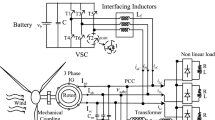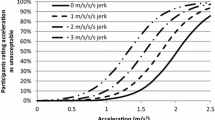Abstract
Purpose
This paper considers the air gap tracking problem of the levitation control system for medium and low-speed maglev vehicles subject to magnetic nonlinearities and track irregularities.
Method
The static and dynamic magnetic field characteristics are investigated, and an improved electromagnetic force model to consider both the magnetic saturation and eddy current effect is developed. By merging neural networks (NNs), a robust adaptive control scheme is proposed, which can deal with the modeling uncertainties and magnetic nonlinearities without requiring precise model information, leading to enhanced levitation performance from the aspects of suspension safety and ride comfort. Based on the Lyapunov method, the continuity of the control signal and uniformly ultimately boundedness(UUB) of all closed-loop signals can be guaranteed.
Results and conclusion
With the dynamic model of the whole suspension bogie and random irregularities, numerical simulations under various operation conditions, including constant speed, horizontal curve and vertical curve, validating the developed control scheme improves the suspension safety while maintaining the ride comfortability for passengers.
















Similar content being viewed by others
Data availability
The authors declare the data availability for this study.
References
Lee HW, Kim KC, Lee J (2006) Review of Maglev train technologies. IEEE Trans Magn 42:1917–1925. https://doi.org/10.1109/TMAG.2006.875842
Yan L (2008) Development and application of the Maglev transportation system. IEEE Trans Appl Supercond 18:92–99. https://doi.org/10.1109/TASC.2008.922239
Gong J (2022) Structural form and dynamic characteristics of high-speed maglev separated track beam. J Vib Eng Technol. https://doi.org/10.1007/s42417-022-00561-5
Lee JS, Kwon SD, Kim MY, Yeo IH (2009) A parametric study on the dynamics of urban transit maglev vehicle running on flexible guideway bridges. J Sound Vib 328:301–317. https://doi.org/10.1016/j.jsv.2009.08.010
Sun Y, Xu J, Chen C, Hu W (2022) Reinforcement learning-based optimal tracking control for levitation system of maglev vehicle with input time delay. IEEE Trans Instrum Meas 71:1–13. https://doi.org/10.1109/TIM.2022.3142059
Ding J, Yang X, Long Z (2019) Structure and control design of levitation electromagnet for electromagnetic suspension medium-speed maglev train. JVC/J Vib Control 25:1179–1193. https://doi.org/10.1177/1077546318813405
Liu SK, An B, Liu S-K, Guo ZJ (2015) Characteristic research of electromagnetic force for mixing suspension electromagnet used in low-speed maglev train. IET Electr Power Appl 9:223–228. https://doi.org/10.1049/iet-epa.2013.0414
Cho HW, Yu JS, Jang SM et al (2012) Equivalent magnetic circuit based levitation force computation of controlled permanent magnet levitation system. IEEE Trans Magn 48:4038–4041. https://doi.org/10.1109/TMAG.2012.2198800
Shu G, Meisinger R (2011) State estimation and simulation of the magnetic levitation system of a high-speed maglev train. In: Proceedings of 2011 International Conference on Electronic and Mechanical Engineering and Information Technology, EMEIT 2011. IEEE, pp 944–947
Ni F, Mu S, Kang J, Xu J (2021) Robust controller design for maglev suspension systems based on improved suspension force model. IEEE Trans Transp Electrif 7:1765–1779. https://doi.org/10.1109/TTE.2021.3058137
Kang J, Mu S, Ni F (2020) Improved EL model of long stator linear synchronous motor via analytical magnetic coenergy reconstruction method. IEEE Trans Magn 56:1–13. https://doi.org/10.1109/TMAG.2020.3002964
Schmid P, Eberhard P, Dignath F (2019) Nonlinear model predictive control for a maglev vehicle regarding magnetic saturation and guideway irregularities. IFAC-PapersOnLine 52:145–150. https://doi.org/10.1016/j.ifacol.2019.11.665
Yang Q, Chi Z, Wang L (2022) Influence and suppression method of the Eddy current effect on the suspension system of the ems maglev train. Machines 10:476. https://doi.org/10.3390/machines10060476
Ji JC, Yu L, Leung AYT (2000) Bifurcation behavior of a rotor supported by active magnetic bearings. J Sound Vib 235:133–151. https://doi.org/10.1006/jsvi.2000.2916
Ji JC, Hansen CH (2001) Non-linear oscillations of a rotor in active magnetic bearings. J Sound Vib 240:599–612. https://doi.org/10.1006/jsvi.2000.3257
Li Q, Wang H, Shen G (2019) Research on control method of Maglev vehicle-guideway coupling vibration system based on particle swarm optimization algorithm. JVC/J Vib Control 25:2237–2245. https://doi.org/10.1177/1077546319852481
Zhang L, Ji JC (2018) One-to-three resonant Hopf bifurcations of a maglev system. Nonlinear Dyn 93:1277–1286. https://doi.org/10.1007/s11071-018-4258-2
Yang J, Zolotas A, Chen WH et al (2011) Robust control of nonlinear MAGLEV suspension system with mismatched uncertainties via DOBC approach. ISA Trans 50:389–396. https://doi.org/10.1016/j.isatra.2011.01.006
Chen C, Xu J, Lin G et al (2022) Sliding mode bifurcation control based on acceleration feedback correction adaptive compensation for maglev train suspension system with time-varying disturbance. IEEE Trans Transp Electrif 8:2273–2287. https://doi.org/10.1109/TTE.2022.3144518
Bächle T, Hentzelt S, Graichen K (2013) Nonlinear model predictive control of a magnetic levitation system. Control Eng Pract 21:1250–1258. https://doi.org/10.1016/j.conengprac.2013.04.009
Chen C, Xu J, Ji W et al (2019) Sliding mode robust adaptive control of maglev vehicle’s nonlinear suspension system based on flexible track: design and experiment. IEEE Access 7:41874–41884. https://doi.org/10.1109/ACCESS.2019.2906245
Sun Y, Xu J, Qiang H, Lin G (2019) Adaptive neural-fuzzy robust position control scheme for maglev train systems with experimental verification. IEEE Trans Ind Electron 66:8589–8599. https://doi.org/10.1109/TIE.2019.2891409
Hu W, Zhou Y, Zhang Z, Fujita H (2021) Model predictive control for hybrid levitation systems of maglev trains with state constraints. IEEE Trans Veh Technol 70:9972–9985. https://doi.org/10.1109/TVT.2021.3110133
Kim KJ, Han JB, Han HS, Yang SJ (2015) Coupled vibration analysis of Maglev vehicle-guideway while standing still or moving at low speeds. Veh Syst Dyn 53:587–601. https://doi.org/10.1080/00423114.2015.1013039
Kong E, Song JS, Kang BB, Na S (2011) Dynamic response and robust control of coupled maglev vehicle and guideway system. J Sound Vib 330:6237–6253. https://doi.org/10.1016/j.jsv.2011.05.031
Sun Y, Xu J, Xu H et al (2022) Backstepping sliding mode control for magnetic suspension system of maglev train with parameter perturbations and external disturbance. Lecture notes in electrical engineering. Springer, pp 253–267
Sun Y, Xu J, Chen C, Hu W (2020) A Deep Reinforcement Learning Based Control Approach for Suspension Systems of Maglev Trains. In: International Conference on Sensing, Measurement and Data Analytics in the Era of Artificial Intelligence, ICSMD 2020 - Proceedings. IEEE, pp 496–501
Shieh HJ, Siao JH, Liu YC (2010) A robust optimal sliding-mode control approach for magnetic levitation systems. Asian J Control 12:480–487. https://doi.org/10.1002/asjc.210
Shihui J, Dong S, Tianbo Z, Hongze X (2022) Nonlinear robust composite levitation control for high-speed ems trains with input saturation and track irregularities. IEEE Trans Intell Transp Syst. https://doi.org/10.1109/TITS.2022.3178122
Slotine J, Li W (1990) Applied nonlinear control. Prentice hall Englewood Cliffs, NJ
Liu YJ, Li J, Tong S, Chen CLP (2016) Neural network control-based adaptive learning design for nonlinear systems with full-state constraints. IEEE Trans Neural Netw Learn Syst 27:1562–1571. https://doi.org/10.1109/TNNLS.2015.2508926
Li X, Liu X (2018) Backstepping-based decentralized adaptive neural H∞ tracking control for a class of large-scale nonlinear interconnected systems. J Franklin Inst 355:4533–4552. https://doi.org/10.1016/j.jfranklin.2018.04.038
Wang F, Chen B, Lin C et al (2018) Adaptive neural network finite-time output feedback control of quantized nonlinear systems. IEEE Trans Cybern 48:1839–1848. https://doi.org/10.1109/TCYB.2017.2715980
Song Y, Huang X, Wen C (2016) Tracking control for a class of unknown nonsquare MIMO nonaffine systems: a deep-rooted information based robust adaptive approach. IEEE Trans Automat Contr 61:3227–3233. https://doi.org/10.1109/TAC.2015.2508741
Yu P, Song M, Chen Q et al (2021) Dynamic response analysis of medium-speed maglev train with track random irregularities. J Adv Transp. https://doi.org/10.1155/2021/1668496
Acknowledgements
This work was supported by the Shanghai Collaborative Innovation Center for Multi-network and Multi-mode Rail Transit under Grant 28002360012.
Author information
Authors and Affiliations
Corresponding author
Ethics declarations
Conflict of interest
The author(s) declared no potential conflicts of interest with respect to the research, authorship, and/or publication of this article.
Additional information
Publisher's Note
Springer Nature remains neutral with regard to jurisdictional claims in published maps and institutional affiliations.
Rights and permissions
Springer Nature or its licensor (e.g. a society or other partner) holds exclusive rights to this article under a publishing agreement with the author(s) or other rightsholder(s); author self-archiving of the accepted manuscript version of this article is solely governed by the terms of such publishing agreement and applicable law.
About this article
Cite this article
Ren, Q., Zhang, J., Zhou, H. et al. Robust Adaptive Levitation Control for Medium and Low-Speed Maglev with Magnetic Saturation and Eddy Current Effect. J. Vib. Eng. Technol. 12, 2835–2849 (2024). https://doi.org/10.1007/s42417-023-01017-0
Received:
Revised:
Accepted:
Published:
Issue Date:
DOI: https://doi.org/10.1007/s42417-023-01017-0




